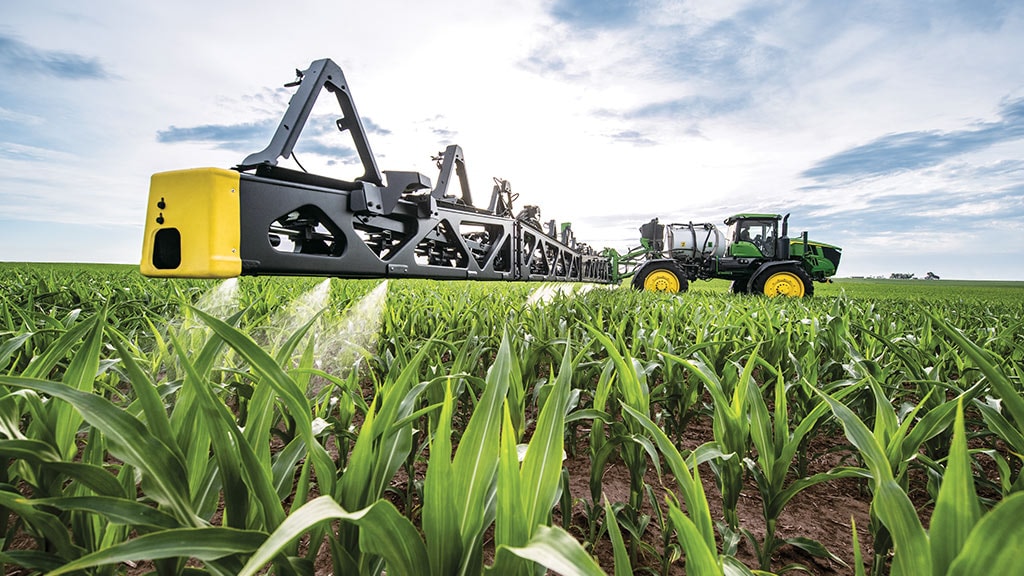
See and Spray Technology by John Deere: Revolutionizing Modern Farming
See and Spray Technology is Revolutionizing Modern Farming.
The Future of Farming
From the earliest days of human civilization, farming has been at the heart of technological innovation. Early tools like plows and hoes, and even the crops themselves, were developed to improve agricultural productivity. Despite these advancements, modern agriculture still faces significant challenges, including the need for vast amounts of land, reliance on fossil-fuel-derived inputs, and vulnerability to weather conditions. Climate change exacerbates these issues, making it harder to feed a growing global population.

Enter Artificial Intelligence
In recent years, artificial intelligence (AI) has emerged as a potential solution to some of agriculture’s most pressing problems. One area where AI is making a significant impact is in the application of herbicides. Traditional methods often involve blanket spraying, which can be wasteful and environmentally damaging. AI-powered tools, however, offer a more targeted approach.
John Deere’s See and Spray Technology
Deere & Co., the company behind the iconic John Deere brand, has introduced a groundbreaking technology known as “See & Spray.” This innovative system uses a special spraying boom equipped with dozens of cameras and a graphics processor. These components work together to identify specific weeds, such as Palmer amaranth, and target them with herbicide, leaving the surrounding crops unharmed.
This technology represents a significant advancement in precision agriculture. By focusing on individual weeds rather than entire fields, it reduces herbicide use and minimizes environmental impact. According to Deere, results from the 2024 growing season showed that See & Spray technology cut herbicide use by nearly 59% on average.

Challenges and Adoption
Despite its promise, See & Spray technology has yet to be widely adopted. Christopher Ciolino, a Bloomberg Intelligence analyst, notes that there isn’t enough data yet to draw meaningful conclusions about its long-term effectiveness. However, Deere is committed to changing this with an aggressive pricing strategy aimed at encouraging more farmers to adopt the technology.
The shift from traditional herbicide application methods to AI-driven targeting represents a significant change in industrial agriculture. For decades, farmers have relied on genetically engineered crops resistant to specific herbicides, allowing for widespread spraying. The new approach, however, focuses on precision and sustainability.
The Economic and Environmental Benefits
The economic logic behind See & Spray technology is clear. Reducing herbicide use lowers costs for farmers and decreases runoff, which can harm plant and animal life outside farms. Additionally, using fewer chemicals can reduce the risk of health issues associated with herbicide exposure.
Farmers have shown a willingness to embrace new technologies, from drones to genetically modified seeds. As farms become increasingly automated, with high-end tractors that can essentially drive themselves, the adoption of AI-powered tools like See & Spray seems like a natural progression.
Successful Implementations of See & Spray in different regions
Here are some examples of successful implementations of John Deere’s See & Spray technology in different regions:
- United States:
- Kansas: Bill Came, a farmer from Salina, Kansas, reported significant savings using See & Spray technology. He mentioned that the technology helped reduce his herbicide costs by two-thirds, making it financially viable to cover the cost of the sprayer.
- Minnesota: Chad Buendorf from New Richland, Minnesota, successfully implemented See & Spray on his farm. He noted that he only needed to spray 11% of his corn acres and 20% of his soybean acres with post-emergence herbicide, leading to substantial cost savings.
- Canada:
- Southern Canada: In arid regions across the U.S. plains and Southern Canada, small grain growers have adopted See & Spray technology to practice chem fallow or summer fallow. This practice involves leaving a field out of production for 8-14 months to conserve soil moisture, and See & Spray has helped optimize herbicide use during this period.
- Iowa, Mississippi, Texas, and Illinois:
- John Deere conducted internal strip trials in these states, focusing on corn, soybeans, and cotton. The trials demonstrated the effectiveness of See & Spray technology in varying weed sizes, crop canopies, and field conditions. The results showed significant herbicide savings and improved crop health.
These examples highlight the versatility and effectiveness of See & Spray technology across different regions and crop types. By reducing herbicide use and improving precision, this technology is helping farmers achieve better economic and environmental outcomes.
How does See & Spray handle different types of crops?
John Deere’s See & Spray technology is designed to be versatile and adaptable to various types of crops. Here’s how it handles different crops:
- Camera and AI Integration: The system uses high-resolution cameras and advanced AI algorithms to differentiate between crops and weeds. This allows it to be used in fields with different types of crops, such as soybeans, corn, and cotton.
- Customizable Settings: Farmers can customize the settings of the See & Spray system based on the specific crops they are growing. This includes adjusting the sensitivity of the cameras and the types of weeds the system targets.
- Training Data: The AI is trained on extensive datasets that include images of various crops and weeds. This helps the system accurately identify and target weeds without harming the crops.
- Field Trials and Feedback: John Deere conducts field trials and collects feedback from farmers to continuously improve the system’s performance across different crop types. This iterative process ensures that the technology remains effective and reliable.
- Compatibility with Existing Equipment: See & Spray technology is designed to be compatible with a wide range of John Deere equipment, making it easier for farmers to integrate it into their existing operations regardless of the crops they grow.
By leveraging these features, See & Spray technology can effectively manage weed control in diverse agricultural settings, helping farmers reduce herbicide use and improve crop yields.
Limitations of See & Spray Technology
While John Deere’s See & Spray technology offers many benefits, it also has some limitations:
- Initial Cost: The technology can be expensive to implement, which may be a barrier for smaller farms or those with limited budgets.
- Data Requirements: The AI system relies on extensive training data to accurately identify weeds. In regions where specific weed types are less common or not well-documented, the system’s effectiveness may be reduced.
- Complexity: The technology requires a certain level of technical knowledge to operate and maintain. Farmers may need additional training to use the system effectively.
- Environmental Conditions: The performance of the cameras and sensors can be affected by environmental conditions such as dust, rain, and low light. This can impact the accuracy of weed identification.
- Crop Variability: While the system is designed to handle different types of crops, variations within a crop (e.g., different growth stages or health conditions) can sometimes lead to misidentification.
- Adoption Rate: Despite its potential, the technology has yet to be widely adopted. This could be due to skepticism about its effectiveness, the need for more field data, or resistance to changing traditional farming practices.
- Maintenance and Upkeep: The advanced equipment requires regular maintenance and updates to ensure optimal performance, which can add to the overall cost and complexity.
- Regulatory and Market Acceptance: The adoption of new agricultural technologies often depends on regulatory approvals and market acceptance, which can vary by region and crop type.
These limitations highlight the need for ongoing research, development, and farmer education to fully realize the potential of See & Spray technology in modern agriculture.
Conclusion
John Deere’s See & Spray technology is a reminder that some of the most promising applications of AI are not the ones that make headlines. While large language models like ChatGPT capture public attention, it’s innovations like See & Spray that have the potential to make a significant impact on our world. By reducing herbicide use and improving crop yields, this technology offers a glimpse into the future of farming, where machines play an increasingly vital role in feeding the global population.
The World’s First Self-Sufficient Floating Farm: Will They Grow?
Largest Agricultural Cooperative In The World





